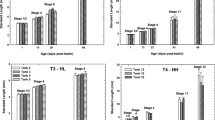Abstract
Cod (Gadus morhua L.) eggs may develop and hatch within temperatures of −1.5 to 12 °C, but little is known about the effects of very low temperatures on larval characteristics. Eggs of the Northeast Arctic cod (Gadus morhua) were incubated at 1, 5 or 8 °C from Day 1 after fertilisation until hatching, and transferred to 5 °C after hatching. Histological samples of the axial musculature were taken at hatching and 5 d after hatching, and the data on muscle cellularity from these samples were related to survival and hatching, size, developmental data and viability of the yolk sac larvae. All larvae hatched at the same developmental stage. Incubation of eggs at 1 °C produced shorter larvae with a larger yolk sac and more, small deep fibres at hatching than larvae from eggs incubated at 5 or 8 °C. The larval size difference was still present 5 d after hatching, a time at which the larvae from 1 °C-incubated eggs were less developed and less resistant to an acute viability stress test (65 ppt salinity). Although there were no differences between temperature groups in number and size of muscle fibres 5 d after hatching, the deep fibres of the 1 °C-group contained less myofibrils than the two other groups. The phenotype of the larvae at hatching was thus affected within these incubation temperatures. Although all groups were transferred to the same temperature after hatching, the lowest egg incubation temperature (1 °C) still had a negative effect 5 d after hatching, as these larvae were both smaller, less resistant to stress and had less functional muscles at the time of first feeding. Our conclusion is therefore that 1 °C is close to, or below, the lower thermal tolerance limit for normal functional development of Northeast Arctic cod. The results are discussed in relation to larval viability and recruitment of this species in the wild.
Similar content being viewed by others
Author information
Authors and Affiliations
Additional information
Received: 4 February 1998 / Accepted: 10 July 1998
Rights and permissions
About this article
Cite this article
Galloway, T., Kjørsvik, E. & Kryvi, H. Effect of temperature on viability and axial muscle development in embryos and yolk sac larvae of the Northeast Arctic cod (Gadus morhua). Marine Biology 132, 559–567 (1998). https://doi.org/10.1007/s002270050421
Issue Date:
DOI: https://doi.org/10.1007/s002270050421




